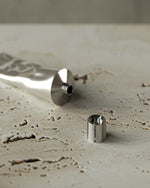20.03.19 in inspirations
Richard Buckminster Fuller

Sometimes a really bad idea can give rise to a bigger one...
At age 32, Richard Buckminster Fuller considered committing suicide one fall morning by swimming to exhaustion in Lake Michigan. By the time he got into the water, he had an epiphany in the belief that a single individual could help change the world and benefit all of humanity. Born in 1895, the American “Bucky” became an architect, designer, inventor, writer and futurist. Among his inventions and numerous patents with a humanist vocation, we know that of the geodesic dome (from the Greek word meaning “to divide the earth”), the fruit of his geometric obsession, of his mathematical grail, of the systematism of his thought.
Each geodesic sphere is made up of isocahedrons, 3-dimensional solids composed of twenty faces, forming golden rectangles between them: an aesthetic imperative essential to the Fuller method which echoes the LE GRAMME aesthetic.
The man some call the “Leonardo da Vinci” of the 20th century said:
“When I'm working on a problem, I never think in terms of aesthetics. But when I’m done, if my solution isn’t beautiful, I know it’s wrong.” The absolute form of Fuller's first dome saw the light of day in 1949, it supported its weight without mechanical limit, success began for this misfit, non-conformist, twice expelled from Harvard.
In 1954, Fuller began collaborating with architect Shoji Sado, together designing the dome of the USA pavilion for the Montreal World's Fair, now named "The Biosphere". It is consecration. The Biopshère has become an environmental museum, a reflection of the ecological activism Fuller professed in his work.
He created the concept Dymaxion (neologism compressing the terms dynamic, maximum and tension) through which he invented the Dymaxion Car, Dymaxion Bathroom, Dymaxion Sleep, Dymaxion Home, each creation aiming to improve the fate of humanity, to coexist harmoniously with ecosystems, to take advantage of the forces of matter and form. The best known expression of Dymaxion is certainly the Dymaxion Map: a planisphere divided into twenty repositionable triangles which make up an isocahedron. The unconventional object nevertheless reestablished the reality of land masses corrupted by Mercator as much as it overturned the North-South concept deemed unsuitable for humanity by Fuller. Doing more and more with less and less, to the point of doing everything with nothing, the visionary designer's adage resonates with LE GRAMME's bias which consists of exploring geometric form to derive a universality that makes sense for everyone. , which addresses a community in the broad sense through the purity of its forms.
Although a visionary, Buckminster did not wear a bracelet or ring (beyond his wedding ring), nevertheless this great traveler was known to have at all times no less than three watches on his wrists corresponding respectively to the country's time in where he was, where he had left and where in the world he was going. A world that now has 300,000 geodesic domes.
At age 32, Richard Buckminster Fuller considered committing suicide one fall morning by swimming to exhaustion in Lake Michigan. By the time he got into the water, he had an epiphany in the belief that a single individual could help change the world and benefit all of humanity. Born in 1895, the American “Bucky” became an architect, designer, inventor, writer and futurist. Among his inventions and numerous patents with a humanist vocation, we know that of the geodesic dome (from the Greek word meaning “to divide the earth”), the fruit of his geometric obsession, of his mathematical grail, of the systematism of his thought.
Each geodesic sphere is made up of isocahedrons, 3-dimensional solids composed of twenty faces, forming golden rectangles between them: an aesthetic imperative essential to the Fuller method which echoes the LE GRAMME aesthetic.
The man some call the “Leonardo da Vinci” of the 20th century said:
“When I'm working on a problem, I never think in terms of aesthetics. But when I’m done, if my solution isn’t beautiful, I know it’s wrong.” The absolute form of Fuller's first dome saw the light of day in 1949, it supported its weight without mechanical limit, success began for this misfit, non-conformist, twice expelled from Harvard.
In 1954, Fuller began collaborating with architect Shoji Sado, together designing the dome of the USA pavilion for the Montreal World's Fair, now named "The Biosphere". It is consecration. The Biopshère has become an environmental museum, a reflection of the ecological activism Fuller professed in his work.
He created the concept Dymaxion (neologism compressing the terms dynamic, maximum and tension) through which he invented the Dymaxion Car, Dymaxion Bathroom, Dymaxion Sleep, Dymaxion Home, each creation aiming to improve the fate of humanity, to coexist harmoniously with ecosystems, to take advantage of the forces of matter and form. The best known expression of Dymaxion is certainly the Dymaxion Map: a planisphere divided into twenty repositionable triangles which make up an isocahedron. The unconventional object nevertheless reestablished the reality of land masses corrupted by Mercator as much as it overturned the North-South concept deemed unsuitable for humanity by Fuller. Doing more and more with less and less, to the point of doing everything with nothing, the visionary designer's adage resonates with LE GRAMME's bias which consists of exploring geometric form to derive a universality that makes sense for everyone. , which addresses a community in the broad sense through the purity of its forms.
Although a visionary, Buckminster did not wear a bracelet or ring (beyond his wedding ring), nevertheless this great traveler was known to have at all times no less than three watches on his wrists corresponding respectively to the country's time in where he was, where he had left and where in the world he was going. A world that now has 300,000 geodesic domes.
“Doing more and more with less and less, until doing everything with nothing, the adage of the visionary designer resonates with the bias of LE GRAMME”






